How to Make Easy Sourdough Bread Recipe
Have you wanted to learn how to make sourdough but felt intimidated by the process? Or have you always dreamt of making fresh bread for you family, warm from the oven, but just felt like it was too great of a commitment?
This post may contain affiliate links. As an Amazon Associate, I may receive a small commission, at no cost to you, if you make a purchase. Please read our disclosure policy.
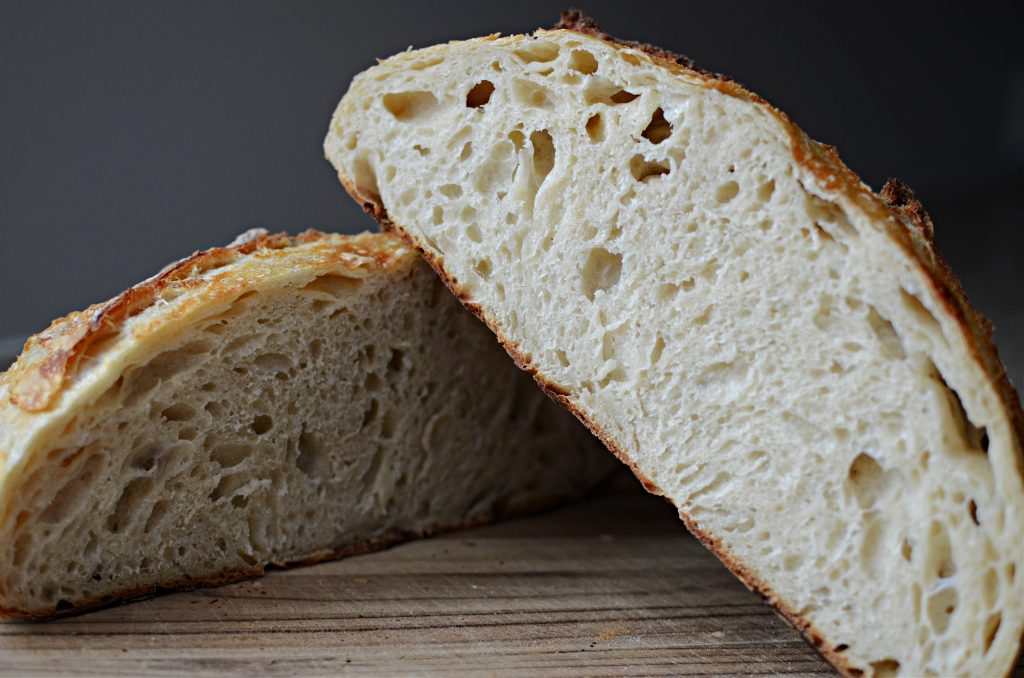
Come along and learn how to make this easy sourdough bread recipe that feeds our family. It has a great crust, lovely, airy crumb, delicious flavor, and most importantly, this easy recipe is simple enough for me to commit to making homemade bread over the past few years. I love that my family is getting one less source of preservatives, simply made with flour, salt, and water as it has been throughout much of history.
What is Sourdough?
Now you may be asking what all the hype has been about with sourdough. If you rub shoulders with certain groups of people, you may have overheard sourdough chitter chatter, people talking about hydration or have seen some swapping starters. What does it all mean?
Sourdough bread is bread that has been leavened with wild yeast and bacteria (lactic acid bacteria) that have been captured from the environment. Left alone to ferment, the bacteria start to create carbon dioxide, which gives the bread it’s rise and also gives the bread that trademark tang.
Like many cultured foods, the sourdough starter acts as “the mother” similar to apple cider vinegar or kombucha and will need regular maintenance. When you’re ready to bake then you add part of the starter to the dough. The remaining part of the starter is kept for the next time you want to bake with it, and this is what is maintained.
After the starter is fed and you use what you need for a recipe you can cover it and place it back in the refrigerator until the next time you plan to bake with it. A starter left in the refrigerator can be fed once a week. A starter left at room temperature will digest the flour at a faster pace and will need to be fed every 1-2 days.
You can find how to make your own starter here.
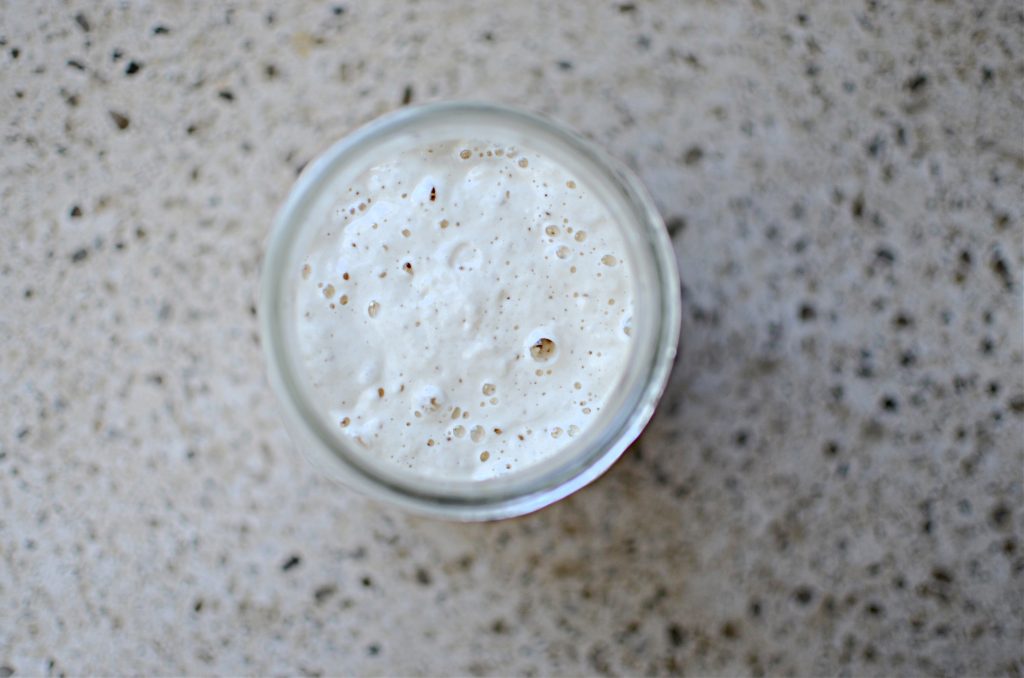
Benefits of Sourdough
What sets sourdough apart from bread made with commercial yeast? The benefits are due to its unique preparation method. The long fermentation process increases the acidic conditions and helps to produce enzymes that partially break down the proteins, including gluten. While not eliminating the gluten, the fermentation lowers the overall gluten and also breaks down the phytic acid to help make the bread easier to digest.
Easy Sourdough Bread Ingredients
- Active sourdough starter
- All-purpose flour
- Warm water
- Salt
How to Make Sourdough Bread Instructions
The beautiful thing about this recipe is that there is so much room for it to be flexible. I’ll admit, when I first started to make sourdough, the flexibility was frustrating. I wanted a predictable schedule with some hard and fast guidelines. It was frustrating because I didn’t understand the process. The best way to gain better understanding is to simply do. With each experience you’ll gain new insights and it will become like second nature.
Feed the Starter
Feed the sourdough starter a ratio of 1:1:1, or equal parts sourdough starter, flour and water 4-12 hours before mixing the dough. Within a few hours you’ll see the sourdough starter develop plenty of air bubbles and expand.
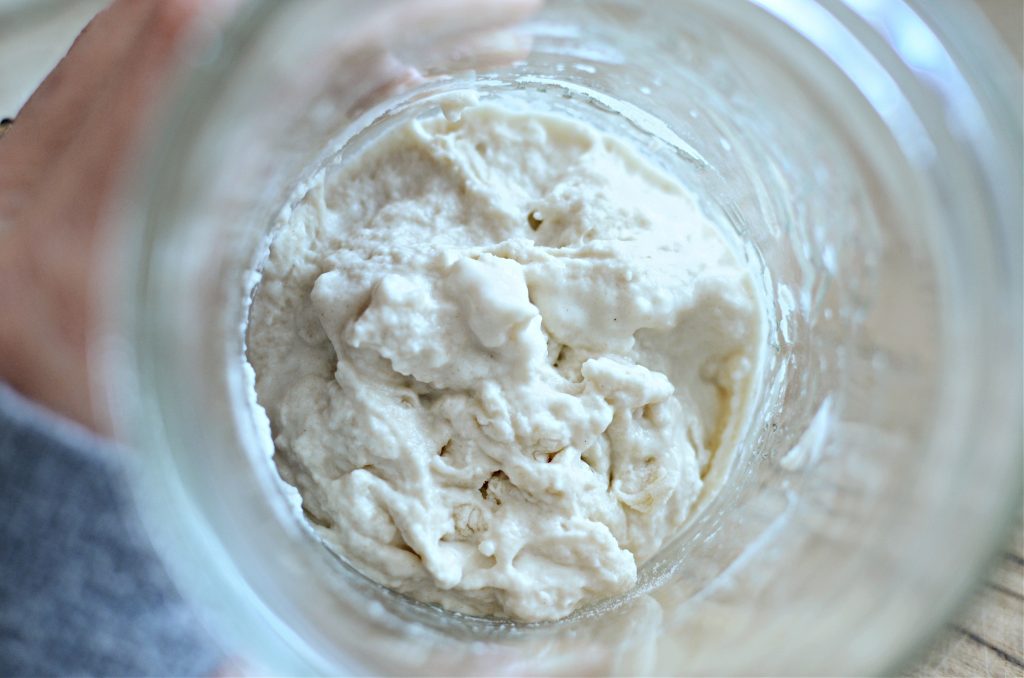
Mixing the Dough
Add the sourdough starter, warm water, and salt to a large mixing bowl and stir lightly to break up the starter. Then add the flour and mix with a dough whisk, making sure that all of the flour in the bottom of the bowl is incorporated with the water.
The dough will look shaggy at first and will not have any elasticity to it at all. Stretched at this point, the dough breaks easily.
Let the dough rest for 15-20 minutes so that the flour can properly hydrate.
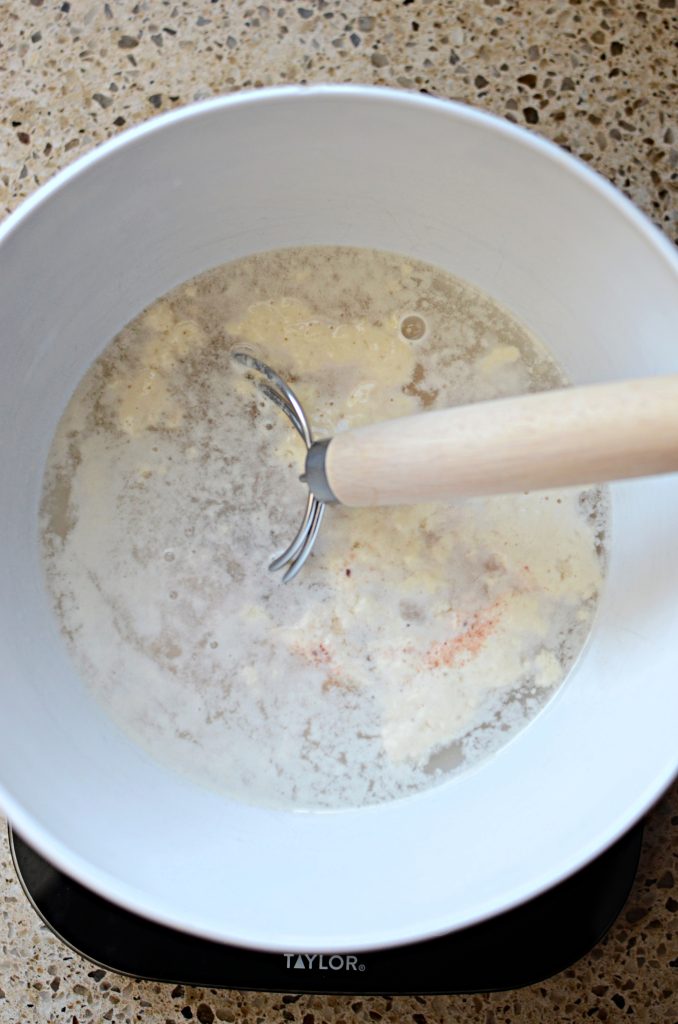
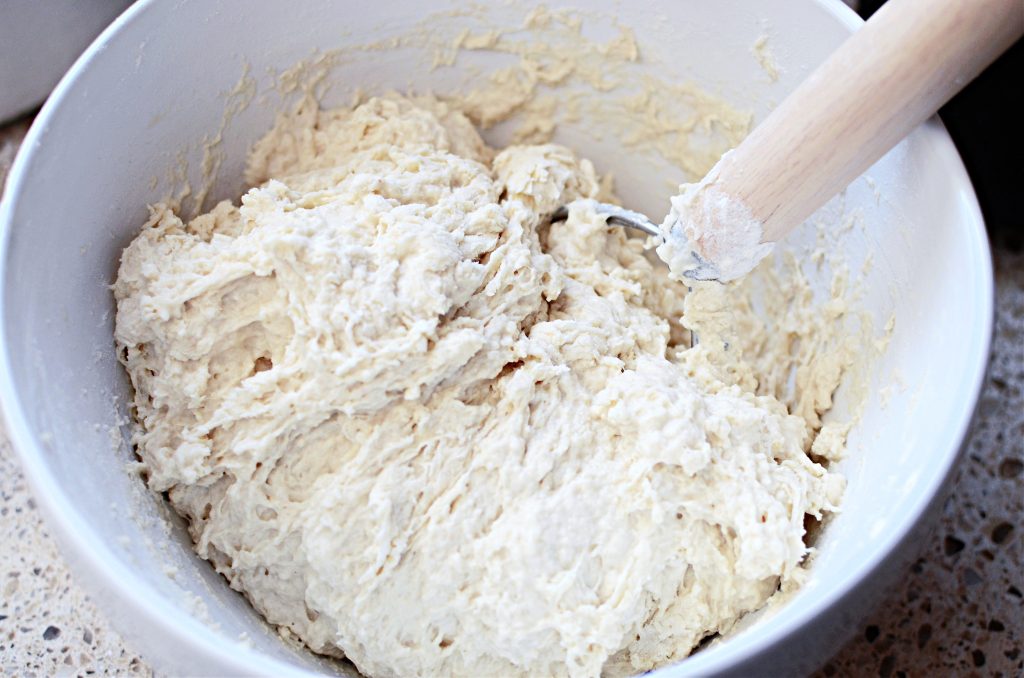
Stretch and Folds
Instead of kneading the dough to strengthen the gluten we are going to do a series of stretch and folds. Grab the edge of the dough and lift it straight up, stretching the dough. Then fold it over, pressing into its middle. Rotate the bowl a quarter turn, and repeat the stretch and fold again.
Continue to stretch and fold the dough 5-8 times, or until the dough become stiff and feels resistant. This completes one set of stretch and folds.
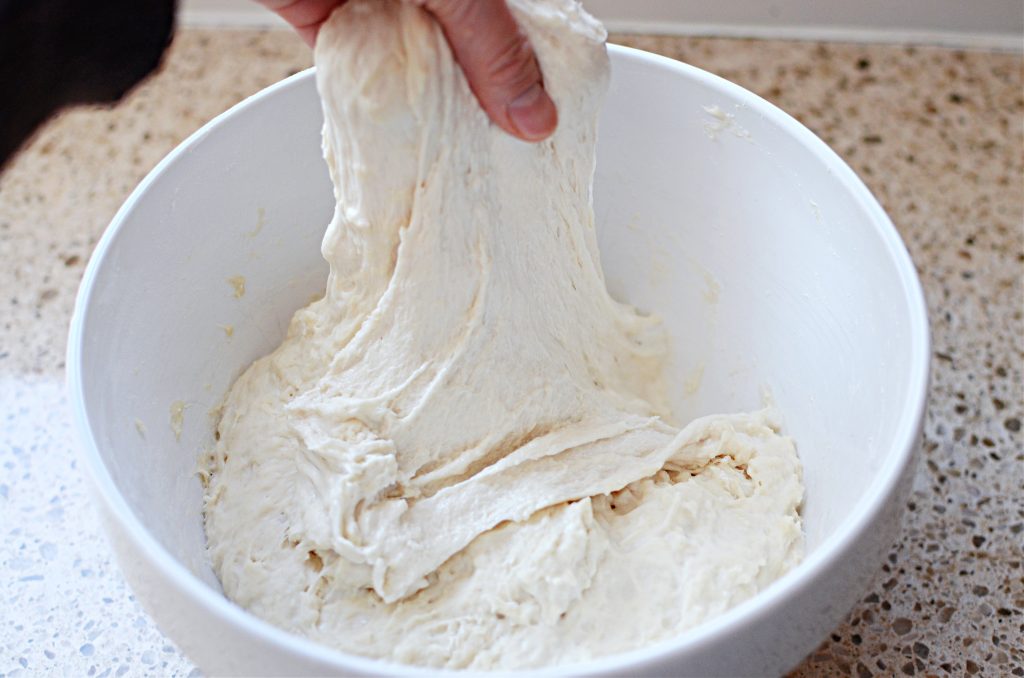

Wait 15 minutes and do another set of stretch and folds.
Repeat the sets of stretch and folds until the dough becomes smooth and elastic when stretched out and holds when stretched thinly. This shows that the gluten has been fully developed and is strong enough to hold the air pockets. This is usually achieved in 2-4 set of folds.
Bulk Fermentation
After the last set of stretch and folds cover the bowl with a plate or plastic wrap and set in a warm place at room temperature for 8-12 hours. Rise times may vary based on how warm your kitchen is and the strength and health of your starter.

The Poke Test
The next day check the dough to see if it’s ready to bake using the poke test. Using a floured finger, poke into the dough about an inch.
One of three things will happen.
First, the dough springs back all the way and fills the hole immediately. If this happens, then it needs more time to ferment.
Or the dough springs back partially and you know it is ready to bake.
If the dough doesn’t spring back at all, it is overproofed and will not rise much when baked. All is not lost though! The bread will still have a beautiful flavor but will just be a bit more dense. You can turn over-proofed bread into delicious croutons, breadcrumbs, or flatbread. I always enjoyed freshly baked bread, regardless of how dense it was!
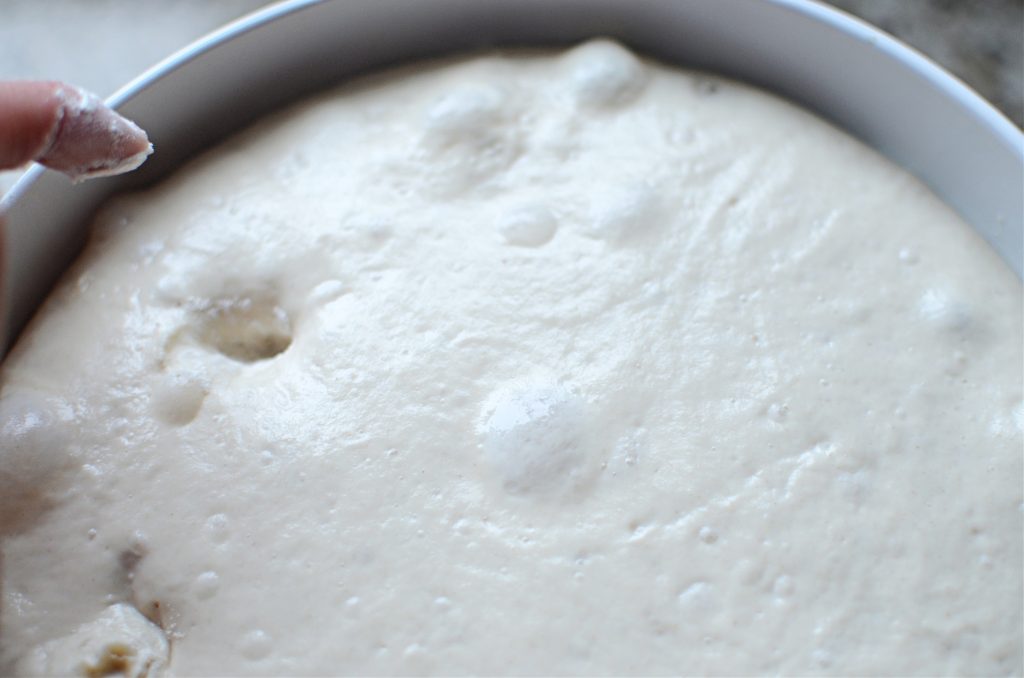
Once you get into a rhythm, you will know when the dough is ready by how it looks in your bowl. I make two loave each time I bake using the same two bowls, and rarely do the poke test anymore. Although there are some mornings I wake up to dough pushing up the plate. I simply lift the plate enough to reach my hand in, scrape the dough off of the plate and continue on.
Shaping the Dough
On a lightly floured work surface, scrape the dough out of the bowl with a dough scraper or rubber spatula and gently stretch roughly into a circle. With lightly dusted fingers or a bench scraper, lift the top of the dough and fold down to the middle of the dough.
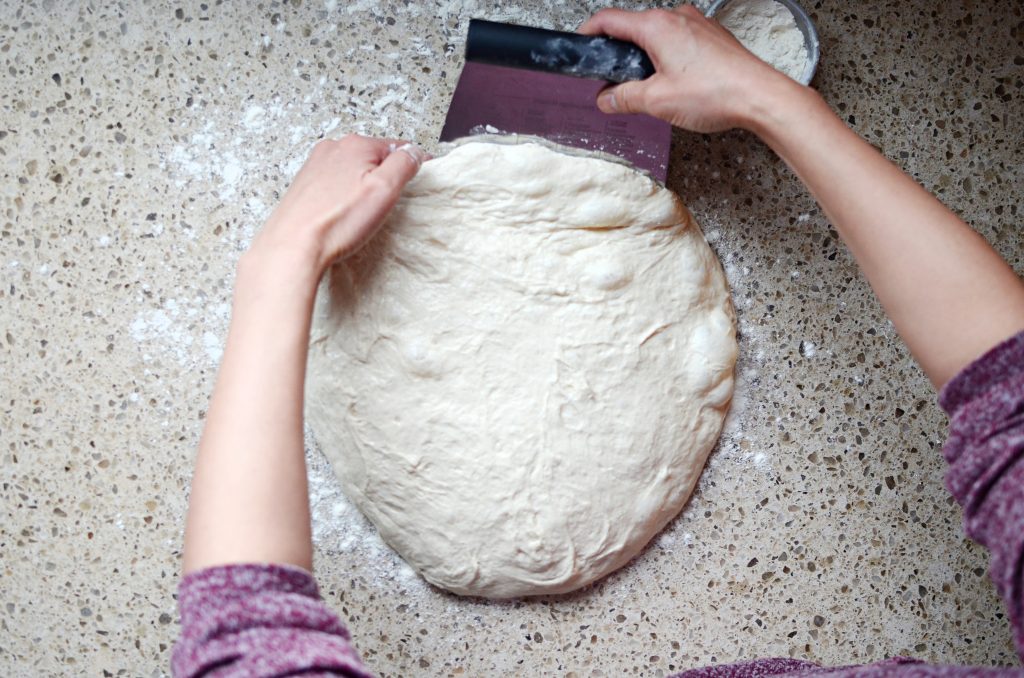
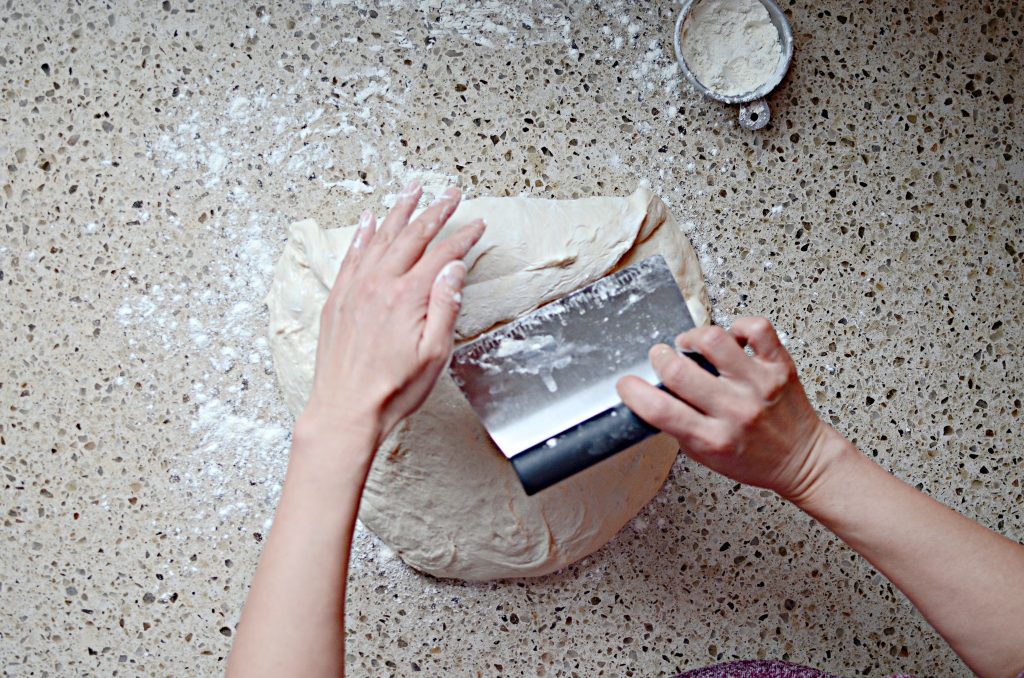
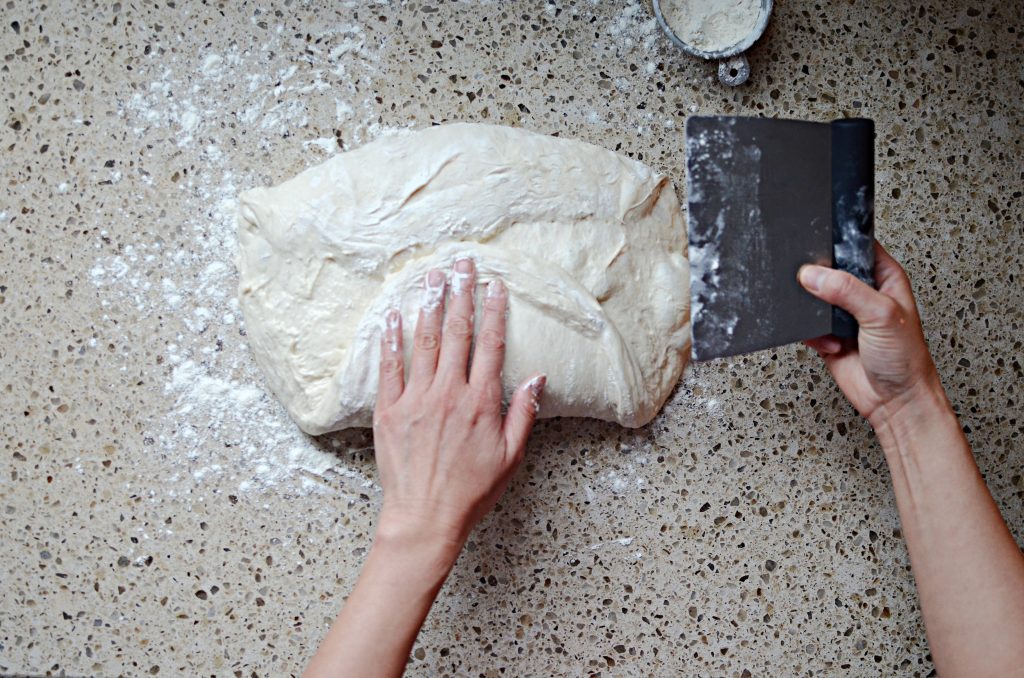
Next, grab the bottom of the dough and fold up to the middle of the dough. Repeat for each side of the dough.
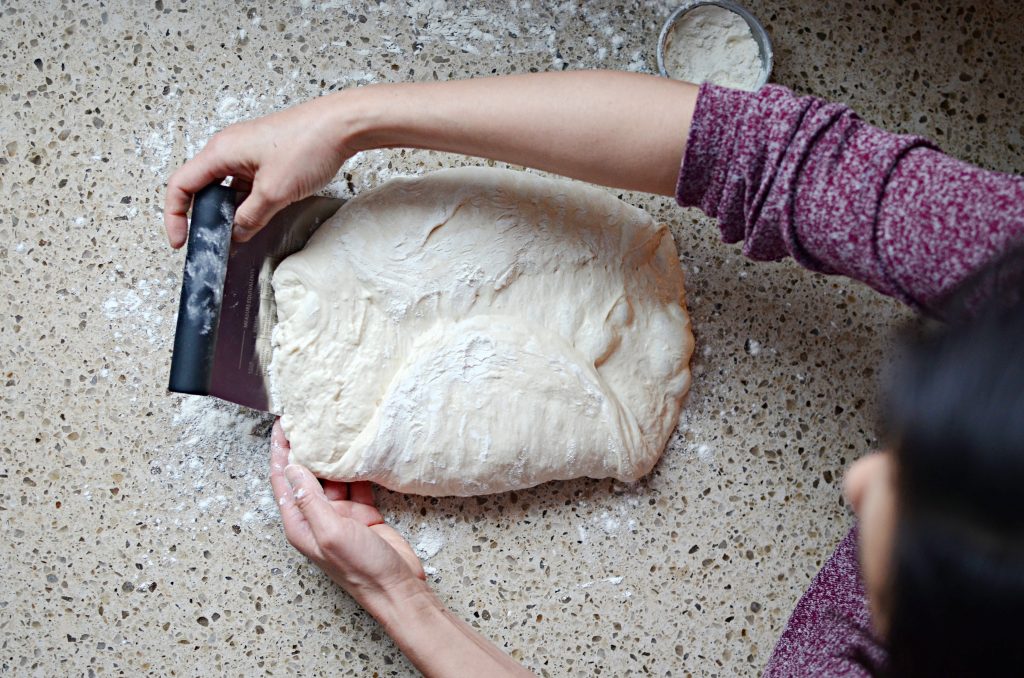

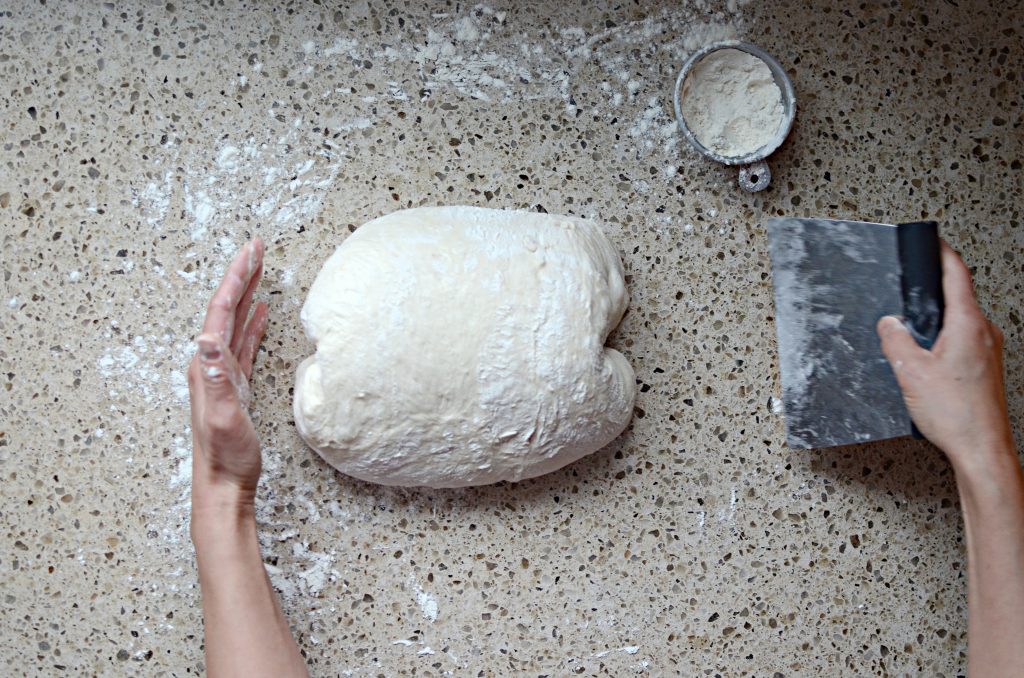
After all 4 sides of the dough are folded over to meet in the middle, using the bench scraper, gently flip the dough over so that the seams of the dough are on the bottom. To shape the loaf into a boule, using both hands, cup the loaf on the side furthest from you.
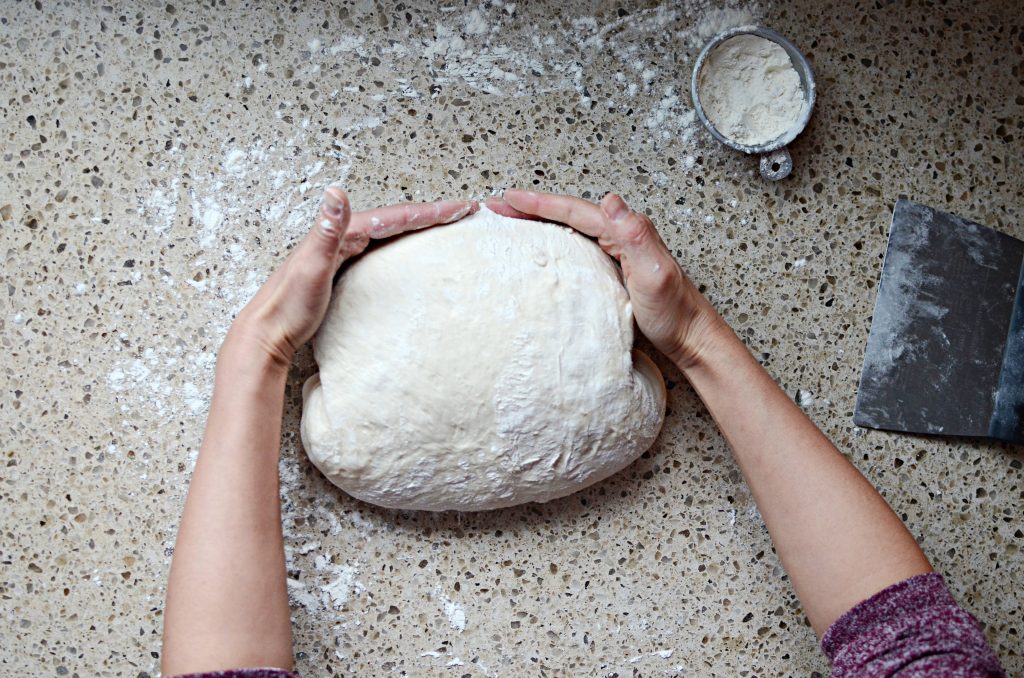
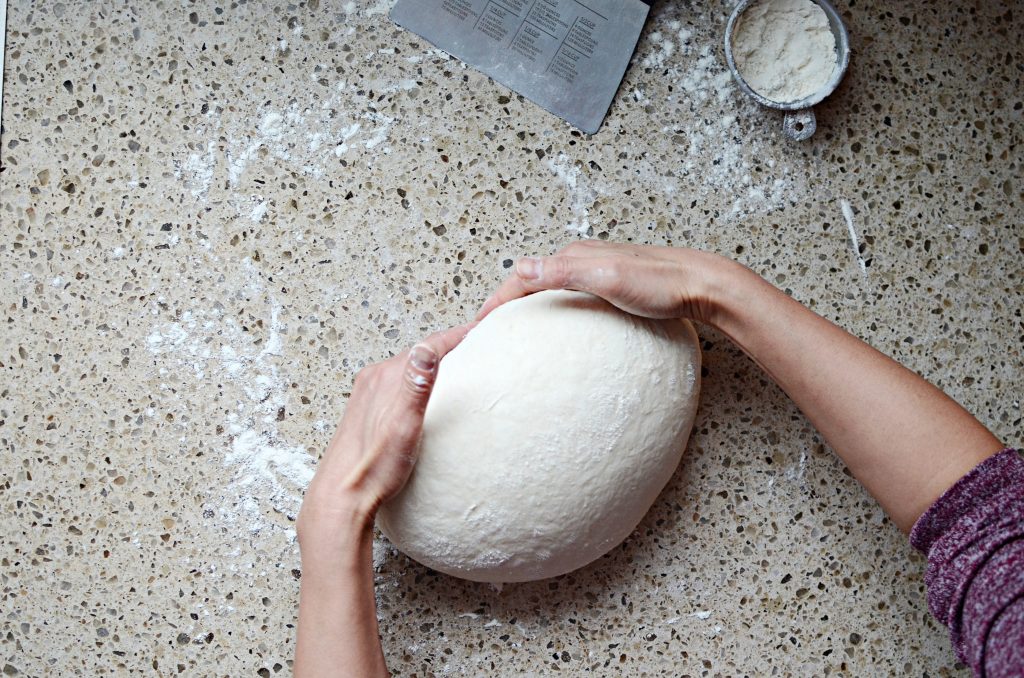
Gently drag the dough towards you with your hands, tuck the loaf under with the edge of your hands. Rotate the loaf a quarter turn and do the same process. The seam should continue to remain on the bottom of the loaf. This will create tension on the top of your loaf and help with oven spring, creating a taller baked loaf.
Cold Ferment and Oven Preheat
Place the dough seam side up into a banneton that’s been dusted with rice flour. Wrap the banneton into a plastic bag and place in the refrigerator to cold ferment until ready to bake.
What if You Don’t Have a Banneton?
Lift the dough onto a piece of parchment paper, seam side down, and place back into the bowl. Cover the bowl again and place in the refrigerator for an hour while the oven preheats. The bread can be left in the refrigerator for up to 18 hours before baking.
If baking right away, preheat the oven with the Dutch oven and lid to 450 degrees for 60 minutes. Place the dough in the refrigerator while the oven preheats.
Score and Bake
When the oven is done preheating remove the dough from the fridge. Score the top of the loaf using a lame or sharp knife, then carefully lift the dough into the hot Dutch oven, quickly replacing the lid and back into the oven.
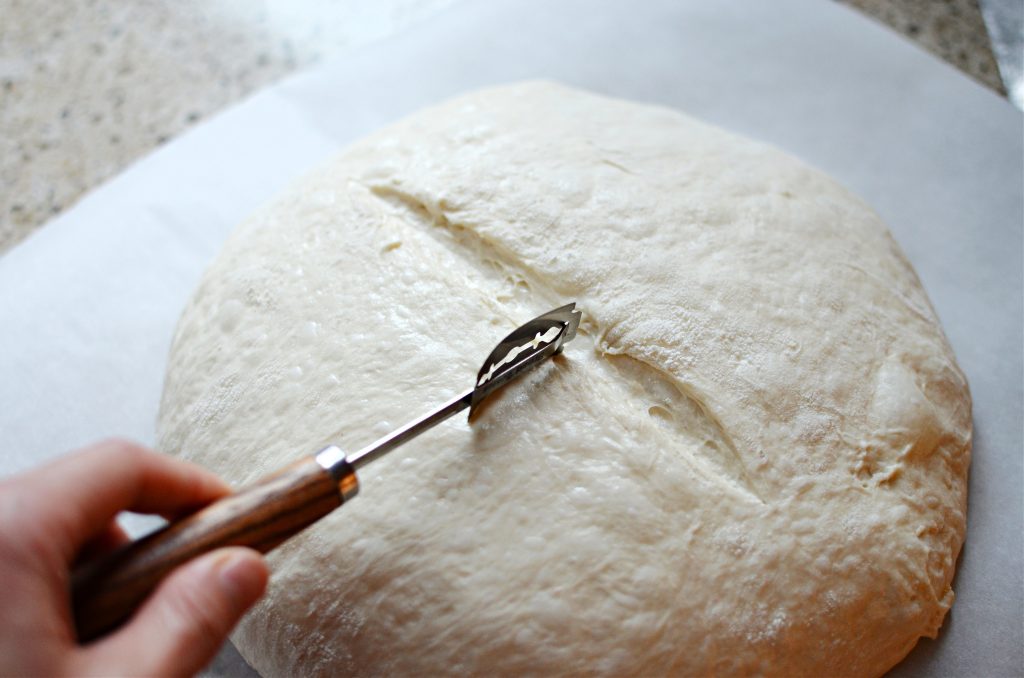
When the dough is exposed to the high heat the dough will burst open which known as the oven spring. The lid traps the stream in the Dutch oven and gives the loaf a beautiful crust.
Bake for 35 minutes with the lid on.
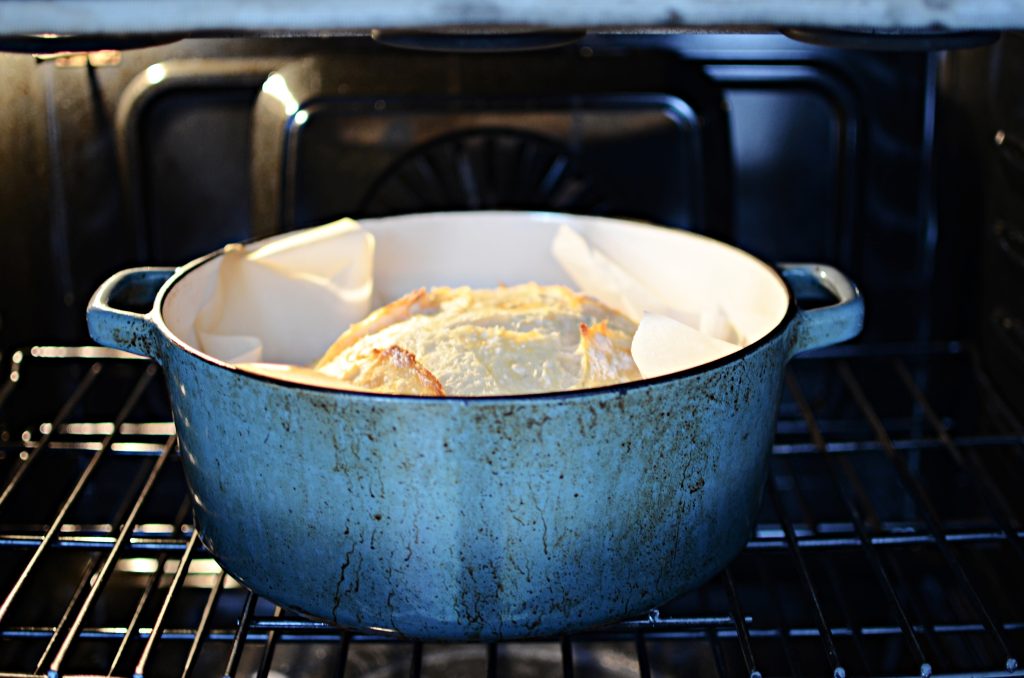
Remove the lid and bake for an additional 10 minutes.
This is the first of two moment that reveals how the loaf will turn out. Did the bread open up? How high did the bread bake? Did I score the dough to produce a lovely ear?
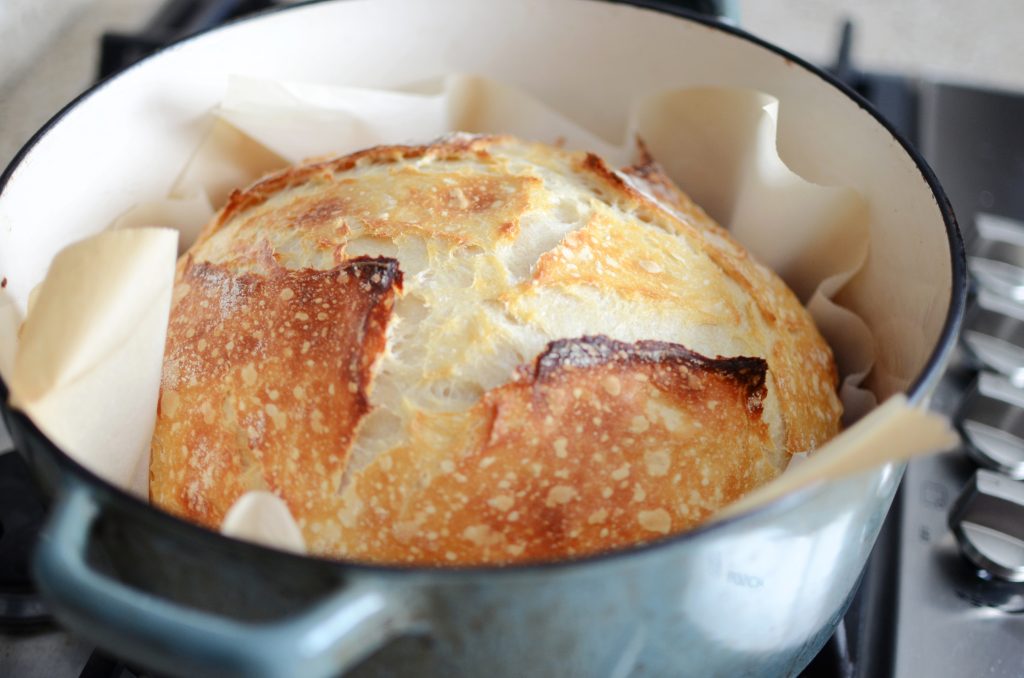
Remove loaf from Dutch oven and give the loaf a gentle tap on the bottom of the loaf, it should sound hollow when done. I like to double check that it’s done with a thermometer, the internal temperature should reach 200 degrees. (I like to take temp from the bottom of the loaf)
Place on wire cooling rack and allow to fully cool before slicing. Cutting into the loaf while its still hot will result in a gummy bread from the high moisture content.
Cutting into the loaf is the second moment of truth. Such anticipation! Is there an even, open crumb? Are the air pockets evenly distributed?
Congratulations! You’ve made a loaf of bread using traditional practices with just a few basic ingredients and some patience.
Storage
Store sourdough bread in an airtight container at room temperature. Best eaten within 3-4 days.
Sample Sourdough Schedule
Day 1:
12:00-2:00 pm – Remove the starter from the refrigerator and feed starter
8:30 pm – Mix the dough
9:00-10:00 pm – Do a series of stretch and folds
10:00 pm – Cover the dough and sit at room temperature to bulk ferment
Day 2:
8:00 am – Shape the sourdough into a boule
8:15 am – Preheat oven and cold ferment
9:00 am – Bake sourdough bread
Tips
- A kitchen scale will give the most accurate results and is worth investing into.
- If the kitchen is cold, place the bowl to bulk ferment in an oven with the light on. It creates a warm space that’s still cool enough to keep the yeast alive.
- Practice. It sounds silly, but it’s one area that’s often overlooked. Most people aren’t masters their first time doing anything, so be patient with yourself and learn to enjoy the process.
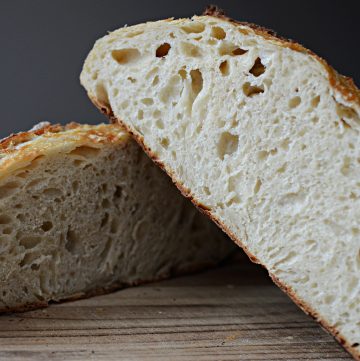
Easy Sourdough Bread Recipe
Equipment
- 1 large mixing bowl
- 1 Danish dough whisk
- 1 Dutch Oven
- 1 bread lame or razor
Ingredients
- 135 grams Starter
- 577 grams Water
- 1 tbsp Salt
- 780 grams Organic Unbleached Flour
Instructions
Feeding the Starter
- 6-8 hours before you want to mix the dough, feed the sourdough starter a ratio of 1:1:1, or equal parts starter, flour, and water of 70 grams each.
- Mix all of these well to incorporate and then cover loosely in a warm spot on the counter. After 6-8 hours, the starter will have plenty of air bubbles and have doubled in size.
Mix the Dough
- Add the sourdough starter, warm water, and salt to a large bowl and stir well. Next, add the flour and mix well. The dough will look shaggy at first. It will not have any elasticity to it at this point and will break when pulled and stretched.
- Let the dough rest for 15-20 minutes so that the flour can properly hydrate.
Stretch and Folds
- Grab the edge of the dough and lift it straight up, stretching the dough. Then fold it over, pressing it into its middle. Rotate the bowl a quarter turn, and repeat the fold again.
- Continue the stretch and folds 5-8 times or until the dough becomes stiff and more resistant. This completes one set of stretch and folds.
- Wait 15 minutes and do another set of stretches and folds. Repeat the sets of stretch and folds until the dough becomes smooth and elastic and holds when stretched thinly. This shows that the gluten has been fully developed and is strong enough to hold the air pockets. This is usually achieved in 2-4 sets of folds.
Bulk Fermentation
- After the last set of stretch and folds, cover the bowl with a plate or plastic wrap and set it in a warm place at room temperature for 8-12 hours. Exact rise times will vary based on the kitchen temperature as well as the strength and health of your starter.
Shaping the Dough
- The next day check the dough by performing the poke test. When it passes, scrape the dough out of the bowl onto a lightly floured work surface. Gently shape it into a circle without deflating it. With lightly dusted fingers or a bench scraper, lift the top half of the dough and fold it down to the middle of the dough. Next, grab the bottom half of the dough and fold it up to the middle of the dough. Fold each side of the dough to the middle.
- After all 4 sides of the dough are folded over to meet in the middle, carefully flip the dough over so that the seams of the dough are on the bottom.
- To shape the loaf into a boule, use both hands and cup the loaf on the side furthest from you and drag it towards you with your hands, tuck the loaf under with the edge of your hands. Rotate the loaf a quarter turn and do the same process. The seam should continue to remain on the bottom of the loaf.
Cold Ferment and Oven Preheating
- Using your bench scraper, lift the dough onto parchment paper and back into the bowl. Cover the bowl again and place in the refrigerator for an hour while the oven preheats. The bread can be left in the refrigerator for 12-18 hours before baking.
- When ready to bake, preheat the Dutch oven and lid to 450 degrees for 60 minutes.
Score and Bake
- When the oven is done preheating score the top of the loaf using a lame or sharp knife.
- Lift the dough using the parchment paper into the hot Dutch oven, add the lid, and back into the oven.
- Bake for 35 minutes with the lid. Remove the lid and bake for an additional 10 minutes.
- After the time is up, remove the loaf from the Dutch oven and give the loaf a gentle tap on the bottom of the loaf. It will sound hollow when it’s done. I like to double check it’s done with a thermometer with the internal temperature at 200 degrees.
- Place on wire cooling rack and allow to fully cool before slicing.
Storage
- Store sourdough bread in an airtight container at room temperature. Best eaten within 3-4 days.

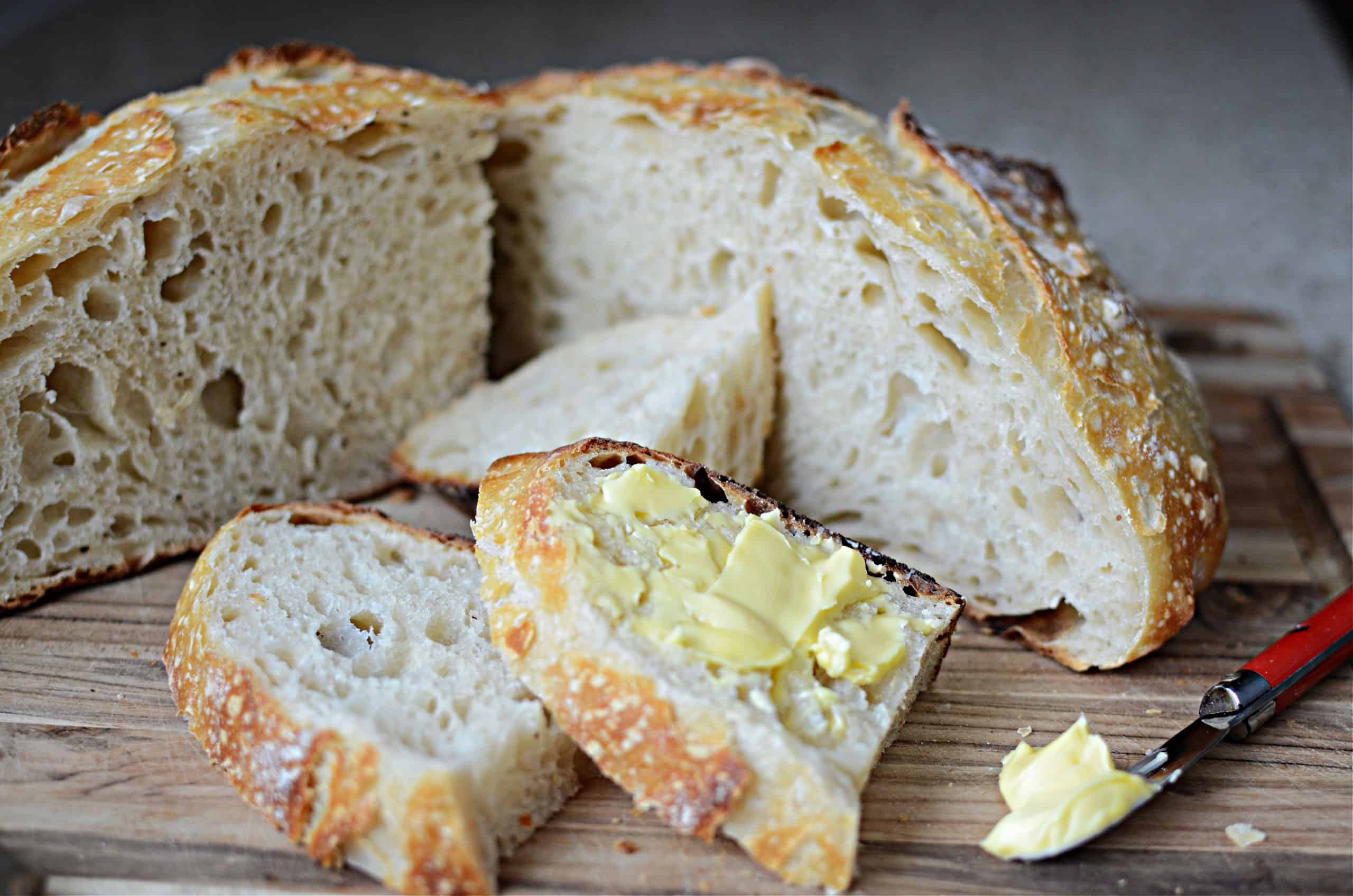
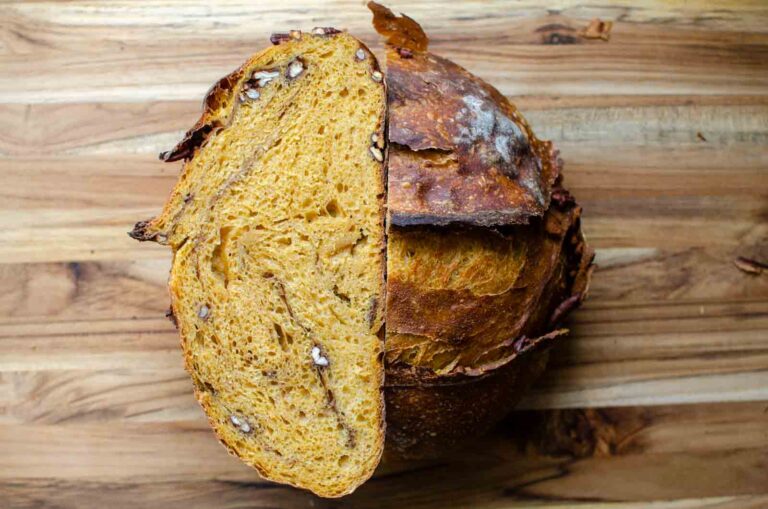
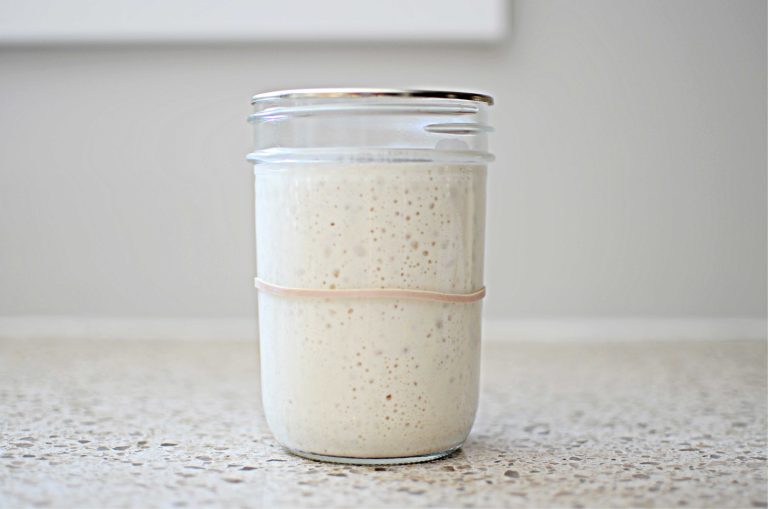
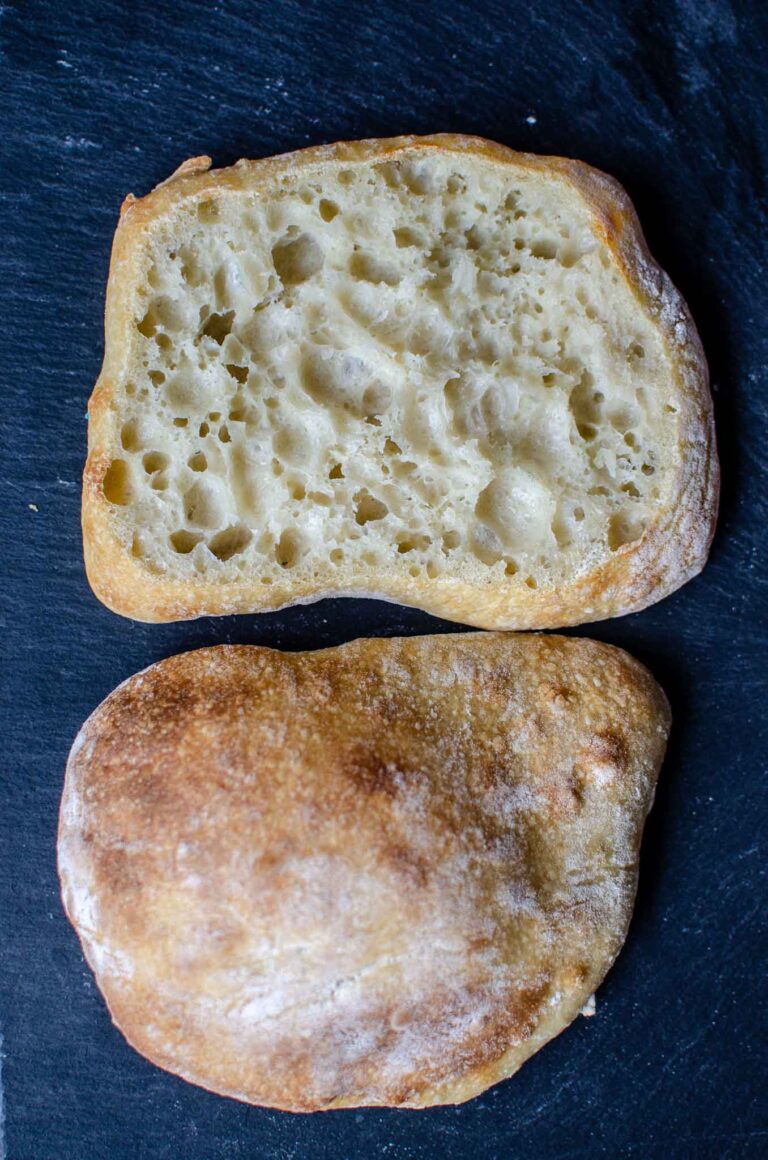

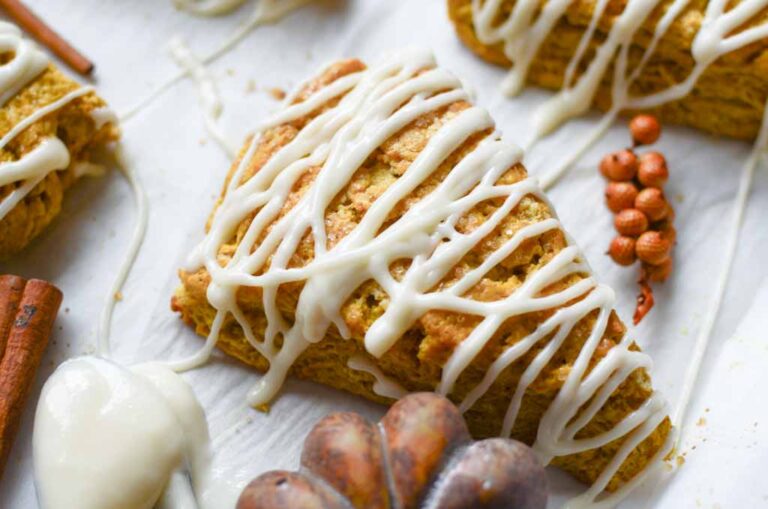

Love your process, your photos, and your beautiful bread my friend!
So fun to learn your way. 🤍
Thank you!